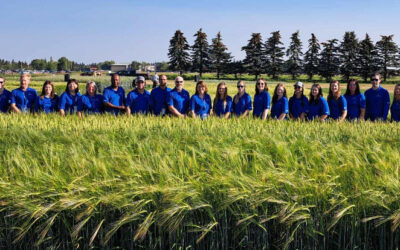The world’s brewing industry is a vibrant and dynamic sector that relies on a multitude of factors to produce a beverage enjoyed by millions of people worldwide. Among the key ingredients that make beer the flavourful drink it is, malting barley is a crucial component. On the June 14 episode of Seed Speaks, we delved into the importance of malting barley to the brewing industry, gaining insights from experts in the field.
The Panel
- Aaron Beattie, University of Saskatchewan — As a malting barley breeder in Saskatoon, Beattie is an expert on the breeding process and works to deliver what maltsters and brewers want.
- Doug Munro, Boortmalt — As a Winnipeg-based merchandising manager for one of the world’s biggest malting companies, Munro knows what makes good malt and what the malting industry wants in barley varieties.
- Dan Simpson, Sookram’s Brewing — Based in Winnipeg, Man., Sookram’s serves Winnipeggers modern craft beer at its taproom and brewery.
- Peter Watts, Canadian Malting Barley Technical Centre — Also based in Winnipeg, Watts is an expert on what the broader value chain wants from malting barley and how adoption of newer varieties is key to supporting the development of the crop.
The Questions:
Marc Zienkiewicz (MZ): Peter, what makes a quality malting barley?
While flavour profiles and other intrinsic qualities are significant considerations, the major factor is the ease and consistency of processing to meet the targeted end-use specifications. The ability to achieve this consistency in both the malt house and the brewery was a crucial reason behind the success of AC Metcalfe and CDC Copeland.
MZ: Dan, for a brewer, what makes a good malt?
Consistency is crucial. We want our malt to be the same every single time we use it, so we don’t have to constantly worry about accounting for any variations. We rely on the fact that our chosen malt will deliver the same results consistently. It allows us to maintain the quality and flavour profiles of our products without any surprises or deviations. Having a reliable and consistent malt means we can focus on other aspects of our process, knowing that this foundational ingredient remains stable.
MZ: Doug, what do you look for in a malting barley that you then turn into malted barley for brewers?
We recognize that different brewers have specific requirements and preferences for their malt. This is why we see a few major malt varieties available. Each of these varieties caters to a different spectrum of what a particular brewer may desire. The choice of malt variety we purchase in larger quantities depends on our customer base for the malt company. For instance, if we serve many adjunct customers, we would look into varieties like CDC Fraser, which possess higher enzyme levels suitable for adjunct brewing. On the other hand, if our focus is on catering to craft brewers, we might consider varieties such as CDC Copeland or AAC Synergy, which have lower protein and enzyme levels. These varieties are better suited for craft brewing practices.
MZ: Aaron, what in your opinion makes a good malting variety?
Our role as breeders is to develop barley varieties that can be grown widely across Western Canada to produce a consistent product that meets the needs of both farmers and the malt industry. We aim to provide variety options with varying enzymatic levels, low beta-glucan levels, and higher extract levels. While flavor is a consideration, we focus on delivering a neutral base for maltsters and brewers to work with, allowing them to shape and enhance the final flavours in their products.
MZ: Peter, how can we speed up adoption of newer varieties?
By investing in breeding programs that prioritize traits like higher yields, improved disease packages, and lodging resistance, we can contribute to the long-term success of the barley industry. These advancements will not only benefit producers by providing them with more productive and resilient varieties but also enhance the marketability and value of Canadian barley for our export customers. It’s important to remain proactive in developing superior genetics that will help sustain the industry’s growth and competitiveness in the future.
MZ: Dan, there’s always a lot of talk about hops in the brewing world. Malt, of course, plays a huge role. How does malt influence your beer?
My journey as an end user has highlighted the importance of understanding the complexities of malting barley and its impact on our brewing endeavors. While my initial focus was on hops, I now realize the significance of malt and its role in achieving consistency and quality in our craft. My primary concern is the usability and consistency of the malt I receive. I don’t have direct knowledge of the specific barley varieties that are used in the malting process. My focus is on ensuring that the malt performs well and provides the desired results in terms of flavour, extract efficiency, and overall consistency in our brewing process.
MZ: Doug, how do you go about introducing new malting varieties to brewers?
The process of introducing a new variety to brewers is time-consuming. It involves malting individual varieties, packaging them, and sending them to interested brewers. The brewers will then conduct flavour tests and, if satisfied, incorporate the new variety into their malt blend, gradually moving it through their system. This process is not swift, and it takes time to ramp up production to meet the volume required for brewers to conduct these tests. Once a variety is registered, it can typically take three to five years for it to become commercially accepted. During this period, brewers begin brewing with the new variety on a commercial scale, and it becomes available in the market.
MZ: Aaron, how do you go about meeting end use demands when creating new varieties and balance that with qualities important to growers like yield etc.?
While we have a good understanding of what maltsters and brewers seek in barley, our major challenges lie in ensuring barley remains a viable option for growers. This necessitates transitioning to new varieties that offer higher yield potential. Balancing the demands of all stakeholders involved in the barley industry is a complex task, but it’s essential to maintaining the industry’s long-term success.
Related Articles
Thanks to Cutting-Edge Barley Breeding, The Craft Beer Boom Means Big Opportunity
First Fully-Commercialized Traceable Beer Could add Value to Certified Seed
Olds College Brewery Launches Traceable Beer Using Blockchain Technology





